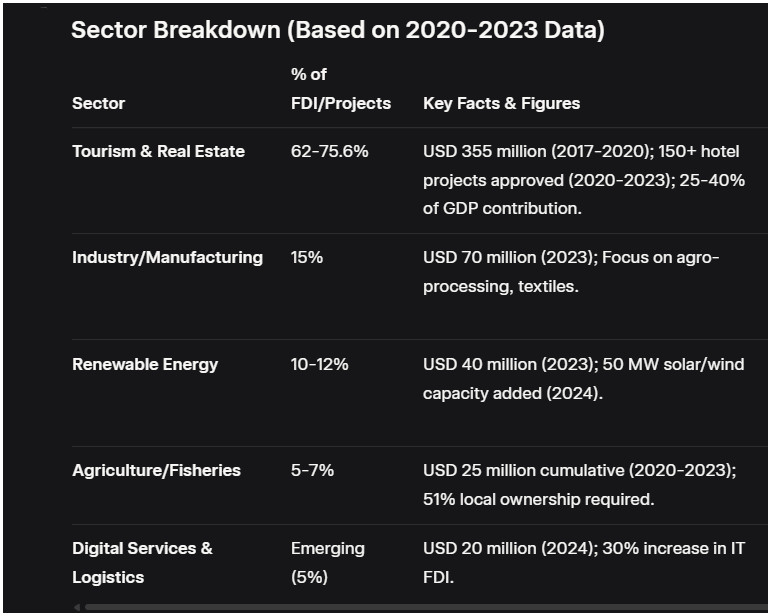
Foreign Direct Investment (FDI) in Cabo Verde
Foreign Direct Investment (FDI) in Cabo Verde: Trends, Figures, and Key Sectors (2020-2025)
Cabo Verde, the Atlantic archipelago bridging Africa, Europe, and the Americas, has emerged as an attractive destination for foreign direct investment (FDI), driven by its stable democracy, investor-friendly policies, and strategic location. With a focus on economic diversification under the Ambition 2030 strategy, the country aims to leverage FDI to boost non-tourism sectors like renewable energy and digital services while sustaining tourism's dominance. Managed through Cabo Verde TradeInvest (CVTI), FDI inflows have shown resilience post-COVID, with approved projects reaching USD 1.5 billion in 2020 alone—equivalent to 75% of GDP. As of October 2025, cumulative FDI from 2017-2020 totaled USD 470 million, with recent years reflecting a rebound and gradual diversification. This article analyzes FDI trends from 2020-2025, highlights main sectors, and provides key facts & figures based on data from UNCTAD, the World Bank, AfDB, and national sources.
FDI Trends and Figures (2020-2025)
Cabo Verde's FDI inflows peaked in recovery phases post-2020, with a 30% year-over-year increase from 2022 to 2023, fueled by tourism rebounds and energy projects. However, net inflows moderated in 2024 amid global uncertainties, stabilizing at around USD 100-150 million annually. Outflows remain negligible, indicating low repatriation pressures.
Key Highlights
- Cumulative (2017-2020): USD 470 million total, averaging ~USD 117.5 million per year—showing steady pre-COVID growth.
- Approved Projects: In 2020, USD 1.5 billion approved (75% of GDP, 96% FDI-driven). By 2023, approvals hit EUR 376 million (~USD 410 million), signaling strong investor confidence.
- Outflows: Very low; 2023 saw just -USD 7.49 million (-0.3% of GDP), mostly from non-priority sector exits.
- FDI vs. GDP: Averaged 5-7% from 2020-2023—well above sub-Saharan Africa's 1.5% average, highlighting Cabo Verde's appeal.
- FDI Stock: Reached ~USD 1.2 billion in 2023 (up 20% from 2020), per UNCTAD.
- Projections: Full-year 2025 inflows eyed at USD 140-160 million, boosted by 6% GDP growth and digital upgrades like the EllaLink cabl
Main Sectors of FDI
Tourism remains the FDI powerhouse, but diversification is accelerating, with energy and industry gaining traction. In 2023, FDI reached EUR 376 million (~USD 410 million), concentrated in services but showing broader spread.

Key Facts & Figures for FDI in Cabo Verde
Economic Impact includes the creation of 5,000 jobs between 2020 and 2023, with FDI contributing 6% to annual GDP growth as estimated for 2024. Incentives Driving FDI feature a 10-year IRPC exemption, VAT relief on imports, and the CIN-CV regime requiring 80% output abroad. Challenges encompass tourism volatility that saw a COVID dip to USD 80 million in 2020, alongside bureaucracy in approvals, though the BUI has reduced this to 75 days. Outlook suggests 2025 inflows are projected at USD 160 million with a 20% year-over-year increase, including a 40% non-tourism share, while the AfDB forecasts 5.5% GDP growth.

